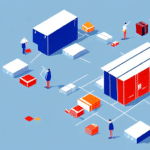Creating a Seamless Transition from 3PL to In-house Operations
As businesses grow, they often face the decision of whether to continue outsourcing their logistics operations to a third-party logistics provider (3PL) or bring those operations in-house. While 3PLs offer numerous benefits such as cost savings and increased flexibility, they can also limit a business's control over their supply chain. Conversely, managing logistics in-house provides better control and visibility but requires more resources and expertise.
Before making the transition from 3PL to in-house operations, it's essential to assess your business needs, resources, and capabilities. This involves a detailed analysis of your logistics infrastructure, including inventory management, transportation operations, and order fulfillment processes. Understanding the pros and cons of 3PL and in-house operations will help you make an informed decision that aligns with your business goals and budget.
Understanding the Pros and Cons of 3PL and In-house Operations
Advantages of Third-Party Logistics (3PL)
- Scalability: 3PLs can easily scale operations to match business growth or seasonal demands.
- Cost Efficiency: Leveraging the infrastructure of a 3PL can reduce capital expenditure on warehousing and transportation.
- Expertise: Access to specialized knowledge and advanced technologies without the need for in-house investment.
- Risk Management: 3PLs often have contingency plans and established relationships with carriers to mitigate risks.
Disadvantages of 3PL
- Reduced Control: Limited oversight over logistics processes can lead to challenges in maintaining service levels.
- Communication Gaps: Potential delays or misunderstandings due to being an external entity.
- Cost Concerns: For businesses requiring high customization, 3PL services may become expensive over time.
Advantages of In-house Logistics
- Enhanced Control: Direct management of logistics operations ensures adherence to specific standards and processes.
- Customization: Ability to tailor logistics strategies and technologies to fit unique business needs.
- Improved Visibility: Greater transparency in supply chain operations can lead to better decision-making.
Disadvantages of In-house Logistics
- Higher Initial Investment: Significant capital required for technology, equipment, and infrastructure.
- Resource Intensive: Requires hiring and training specialized personnel to manage logistics effectively.
- Risk Exposure: Greater responsibility for disruptions such as natural disasters or labor strikes.
Assessing Your Business Needs Before Making the Transition
Before transitioning from 3PL to in-house operations, conduct a comprehensive assessment of your business needs, goals, and budget. This involves:
- Logistics Infrastructure Analysis: Evaluate current inventory management, transportation operations, and order fulfillment processes.
- Performance Metrics: Identify key performance indicators (KPIs) such as order fulfillment times, inventory turnover rates, transportation costs, and customer satisfaction rates.
- Control Requirements: Determine the level of control needed over logistics operations to meet business objectives.
Regularly evaluating these factors will help you decide whether in-house logistics align with your strategic goals and operational capabilities.
Mapping Out a Plan for a Smooth Transition Process
Transitioning from 3PL to in-house operations requires meticulous planning and execution. Follow these key steps to ensure a seamless transition:
- Business Case Development: Clearly articulate the reasons for the transition and secure buy-in from key stakeholders.
- Timeline and Budget: Establish a realistic timeline and allocate a budget that covers all aspects of the transition.
- Project Team Formation: Assemble a dedicated team to oversee and manage the transition process.
- Detailed Logistics Planning: Develop comprehensive plans for inventory management, transportation, and order fulfillment.
- Technology and Equipment: Identify and procure the necessary technology and equipment to support in-house operations.
- Stakeholder Communication: Maintain open lines of communication with carriers, suppliers, and other partners to ensure alignment.
Having a structured plan minimizes disruptions to your supply chain and facilitates a successful shift to in-house logistics.
Additionally, prepare for unforeseen challenges by having contingency plans in place. Transparent communication with customers about changes affecting orders or delivery times helps maintain satisfaction and trust.
Identifying the Key Players in the Transition Process
Successful transitions involve collaboration among various stakeholders:
- Senior Management: Ensure alignment with long-term business objectives and provide strategic direction.
- IT Department: Implement and manage the technology and systems essential for in-house logistics.
- Procurement Department: Handle supplier relationships and negotiate contracts.
- Logistics Personnel: Oversee day-to-day logistics operations and bring specialized expertise.
- Human Resources: Manage workforce changes, provide training, and address employee concerns.
Effective communication and collaboration among these stakeholders are critical for a smooth and efficient transition.
External stakeholders, including customers, suppliers, and partners, should also be engaged to ensure they understand and support the changes. This fosters positive relationships and minimizes potential disruptions.
Preparing Your Team for the Change in Operations
Transitioning to in-house operations necessitates changes in processes, technologies, and roles. To ensure your team is ready:
- Training and Development: Implement comprehensive training programs to equip employees with the necessary skills.
- Clear Communication: Clearly outline the changes and how they will impact daily operations.
- Supportive Environment: Create an atmosphere that encourages feedback and addresses employee concerns promptly.
- Leadership Development: Identify and train key personnel to lead and manage the transition effectively.
Developing simulation exercises and hands-on training can help staff adapt to new systems and processes, ensuring a smooth operational shift.
Establishing Clear Communication Channels During the Transition
Effective communication is vital throughout the transition process to ensure all stakeholders are informed and engaged:
- Information Flow: Establish clear protocols for how information is shared among teams and departments.
- Regular Updates: Schedule consistent status meetings and updates to track progress and address challenges.
- Goal Alignment: Ensure all stakeholders understand the objectives and benefits of the transition.
- Feedback Mechanisms: Implement channels for stakeholders to provide input and raise concerns, facilitating proactive problem-solving.
Maintaining transparent and open communication helps mitigate misunderstandings and keeps the transition on track.
Implementing Best Practices for In-house Operations
Adopting industry best practices is essential for optimizing in-house logistics operations:
- Robust Inventory Management: Utilize advanced inventory systems to track and manage stock levels efficiently.
- Efficient Transportation Operations: Optimize routing and scheduling to reduce costs and improve delivery times.
- Automation and Standardization: Implement automated processes to minimize errors and accelerate order fulfillment.
- Continuous Monitoring: Regularly evaluate logistics performance using data-driven insights to inform decision-making.
Implementing these best practices enhances operational efficiency, reduces costs, and improves customer satisfaction.
Moreover, sustainable practices such as optimizing transportation routes can reduce environmental impact by minimizing carbon emissions. Efficient inventory management also helps in reducing waste and preventing overstocking.
Overcoming Challenges During the Transition Process
Transitioning from 3PL to in-house operations comes with its set of challenges. Being prepared to address these issues is crucial for success:
- Unforeseen Costs: Budget overruns can occur due to unexpected expenses in setting up in-house logistics.
- Internal Resistance: Employees may resist changes, leading to delays and reduced morale.
- Data Migration: Transferring data between systems requires careful planning to ensure accuracy and compatibility.
- Supplier Integration: Shifting to in-house operations can alter relationships with partners and suppliers.
- Technology Implementation: Integrating new technology systems can be complex and time-consuming.
- Staffing Needs: Hiring or retraining staff to manage in-house operations is essential but resource-intensive.
To mitigate these challenges, develop contingency plans, engage in proactive communication, and allocate resources effectively. Investing in robust technology solutions and providing comprehensive training can also help overcome obstacles during the transition.
Measuring Success: Key Metrics to Track Post-Transition
Tracking Key Performance Indicators (KPIs) post-transition is essential to evaluate the effectiveness of in-house operations:
- Delivery Times: Monitor the speed and reliability of shipments to ensure customer satisfaction.
- Order Fulfillment Rates: Track the accuracy and timeliness of fulfilling customer orders.
- Inventory Turnover: Measure how efficiently inventory is managed and replenished.
- Logistics Costs: Analyze overall logistics expenditures to identify cost-saving opportunities.
- Customer Satisfaction: Gather feedback to assess the impact of logistics changes on customer experience.
- Operational Efficiency: Evaluate the effectiveness of new processes and technologies in enhancing workflow.
Regularly reviewing these metrics allows for continuous optimization of logistics operations, ensuring that the transition to in-house management delivers the desired outcomes.
Conclusion
Transitioning from 3PL to in-house logistics operations is a significant undertaking that can offer substantial benefits, including increased control, customization, and potential cost savings. By thoroughly assessing your business needs, developing a comprehensive transition plan, investing in the right technology and training, and maintaining clear communication with all stakeholders, you can navigate the complexities of this transition successfully.
Embracing best practices and continuously monitoring key performance metrics will help ensure that your in-house logistics operations contribute positively to your business's growth and customer satisfaction. With careful planning and execution, the move to in-house logistics can position your business for sustained success in an increasingly competitive market.






















